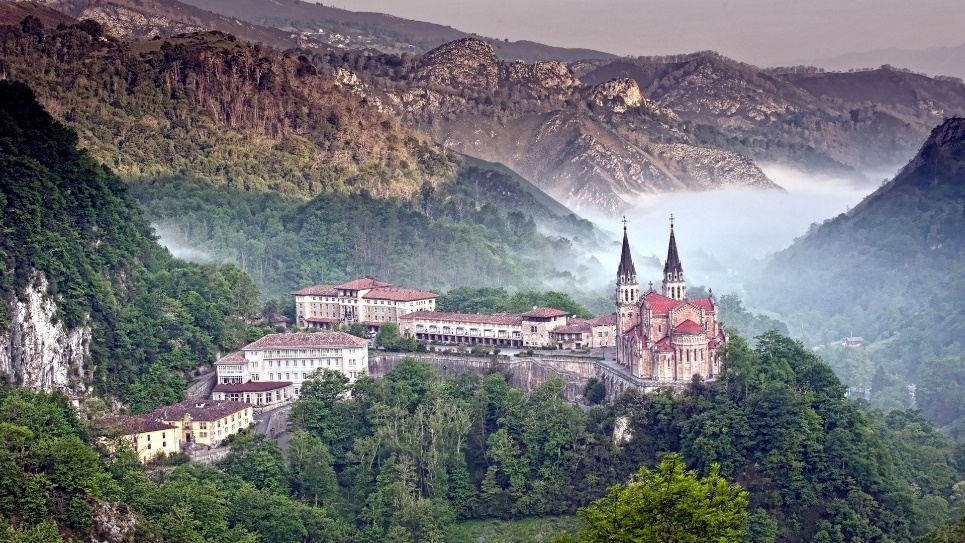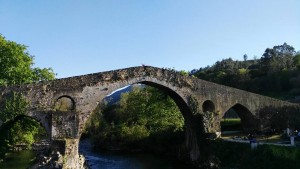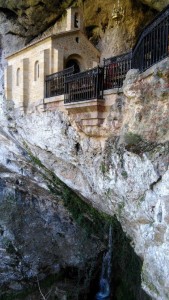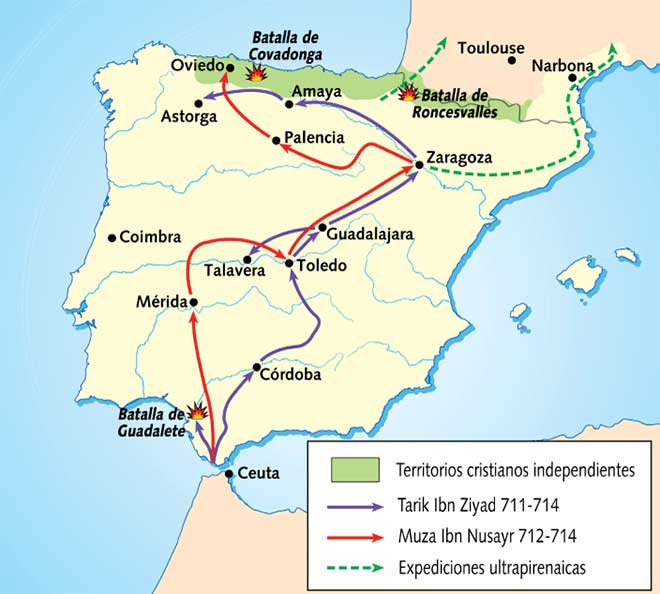La batalla de Covadonga
Este mes fuimos unos amigos y yo a Asturias para ver a mi compañera de piso (que había vuelta a casa para trabajar) mientras estábamos allí visitamos las ciudades de Oviedo, Gijón (un nombre que me cuesta mucho pronunciar) y los pueblos de Cangas de Onís y Covadonga.
El pueblo de Covadonga se encuentra a unos ochenta kilómetros al este de Oviedo y para llegar allí cogimos un bus que nos llevaba por absolutamente todas las montañas de la zona. ¡Qué mareo!
Al llegar allí encontramos una iglesia gigantesca en la cima de una montaña/roca y otra iglesia más pequeña escondida en una cueva de la montaña. Dentro de esa iglesia pequeña se encuentra la tumba de unos de los reyes más famoso de Asturias, el Rey Pelayo.
Antes de ir a Asturias no conocí la historia (aunque había estudiado filología hispánica en la universidad :O) que la batalla de Covadonga era una batalla MUY importante en la historia del peninsular ibérico porque era la primera victoria contra los musulmanes que habían invadido el país. En el resto de España los musulmanes habían ganado tierra sin muchos problemas o mucho contraataque (esto también se debe a que la mayoría habían pasado cientos de años viviendo en España) La batalla tuvo lugar en el año 722 en Covadonga y muchos lo consideran el comienzo de la reconquista en España.
Los asturianos y muchos de los refugiados del resto del país que habían huido el estado musulmán, lucharon desde las montañas que rodean el pueblo de Covadonga, dejando a los invasores sin muchas más opciones que huir al sur del peninsular. Como mencioné en un blog anterior la cultura árabe tiene una presencia muy notable en España y sobre todo en el sur. El hecho de que los asturianos ganaron la batalla y la reconquista empezó desdé allí significa que los musulmanes no dejaron casi ningún rastro de su cultura en Asturias, a diferencia del resto de España.
Después de visitar Covadonga y aprender esta importante lección de cultura hispana nos dirigimos a Cangas de Onís que hoy en día es famoso por su puente romano (que me recordó mucho al puente famoso en Mostar, Bosnia). Allí aprendimos que en el pasado Cangas de Onís había sido el capital de toda Asturias justo en el momento cuando se vencieron a los invasores.
En el capital actual – Oviedo, se puede aprender mucho más sobre el Rey Pelayo y la batalla de Covadonga. En el jardín de los reyes se puede apreciar todos los pasados reyes del reino de Asturias junto con Pelayo. Hay que Asturias sobre todo para aprender un poco más sobre la cultura de la región. ¡Que hoy en día incluye enormes cantidades de sidra!
ENGLISH:
The battle of Covadonga
This month a few of my friends and I went to Asturias to see one of my flatmates (who had gone back home to work), whilst we were there we visited cities like Oviedo and Gijón (a name that causes me lots of trouble to pronounce) and two small towns called Cangas de Onís and Covadonga.
The town of Covadonga is located about fifty miles to the East of Oviedo and to get there we got on a local bus that took us around absolutely every mountain in the area! Travel sickness was a very prominent feeling that day!
When we arrived there we found a giant church on the top of a mountain/big rock and another smaller church hidden away in a cave in the side of the mountain. Inside this little chapel is the tomb of one of the most famous kings of Asturias, King Pelayo.
Before going to Asturias (even though I studied Hispanic studies at university) I didn’t know the story of the Battle of Covadonga and that it was an EXTREMELY important batlle in the history of the Iberian Peninsula. It was the first time the Christian areas were victorious against the Muslim invaders. In the rest of Spain (as can be seen on the map below in yellow, the Muslims gained a very large amount of territory without many problems or counter-attacks. (This is also due to the fact that many Muslims had lived peacefully in Spain for hundreds of years). The battle took place in the year 722 in Covadonga and many people consider it to be the start of the Spanish re-conquest or Reconquista.
The Asturians and many of the refugees who had fled the Muslim state, fought from the mountains that surrounded the town of Covadonga, leaving the invaders with not very many options other than to flee back to the South themselves. As I mentioned in a previous blog post, Arabic culture has a very strong presence in Spain and certainly in the South. The fact that the Asturians won the battle and that the Reconquista began from there, meant that in fact the Muslims left hardly a trace of their culture behind, unlike in the rest of Spain.
After visiting Covadonga and learning this important lesson on Spanish culture, we left for Cangas de Onís, which today is famous for its Roman Bridge. (This bridge reminded me greatly of the famous bridge in Mostar, Bosnia). There we also learnt that this small town had once been the Capital of the whole of the Kingdom of Asturias, just at the time when the invaders were defeated.
In the current capital city –Oviedo, you can learn much more about King Pelayo and the battle of Covadonga. In the Jardín de los Reyes in the city you can see statues of all the past royal members of the Kingdom of Asturias, including Pelayo. I recommend going to Asturias especially to learn a bit more about the culture of the region and the history of Spain. Today in Asturias the main cultural activity involves lots and lots of Cider!



